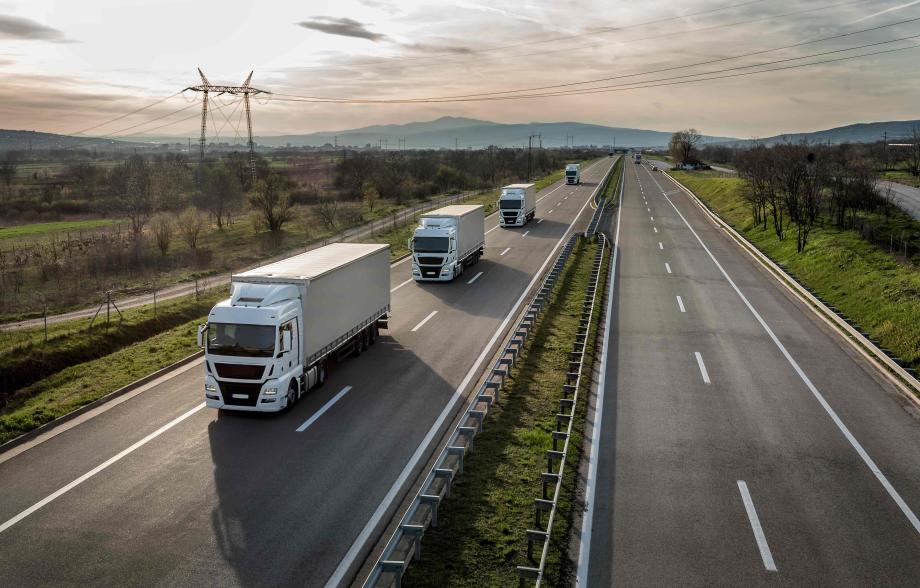New momentum for development of the road freight between Ukraine and Slovakia: what approach should be taken?

Before the war, Slovakia and Ukraine had a low volume of road freight transportation due to a relatively short border length and a small number of border crossings on the Slovakian-Ukrainian border. The Russian aggression in Ukraine caused a significant increase in the transported volumes and a change in the composition of traded categories. As the threat of attack from the east continues to loom and Ukraine becomes more integrated with the European market, the exchange of goods between Slovakia and Ukraine will continue to grow. Slovakian businesses and transportation companies should seize the opportunity to invest in expanding the road and storage infrastructure.
The full-scale aggression of Russia against Ukraine in February of 2022 and the blockage of Ukrainian seaports caused a change in the usual patterns of Ukrainian logistics. After the initial drop in freight volumes between Slovakia and Ukraine, there was a sharp increase in volume and a change in the composition of freight. The road infrastructure of both countries was not ready for such an increase in operations and the introduction of new goods. The inability to quickly process incoming trucks creates queues on both sides of the border.
There are two road border crossings on the Slovakian-Ukrainian border for freight vehicles: Vysne Nemecke – Uzhgorod and Ubla – Maly Berezny.
The main product category that Ukraine exports to Slovakia is “Electrical machinery.” Figure 1 shows that freight transportation by road is relatively diverse, with product categories taking a small share of the total trade volume. For a better visibility, numerous smaller categories were combined in the “Other” category. The volume of exports increased after the start of an active war from EUR 23.3 mn in February 2022 to EUR 41 mn in June 2022, especially for electrical machinery, and new categories appeared – cereals and oil seeds. This happened due to the blockade of seaports and the reorientation of export from ports to the western border of Ukraine.
Ukrainian imports from Slovakia by road saw a drastic drop in almost all categories in March and a similar significant increase in the imports of “Arms and ammunition” and “Aircraft,” which is understandable for a country at war. The imports of all categories except “Arms and ammunition” and “Aircraft” decreased from EUR 43.3 mn in February 2022 to EUR 8 mn in March 2022. The “Arms and ammunition” category increased from 0 in December 2021 to EUR 55 mn in April 2022. There was also a swift rebound of Ukrainian imports after the March drop.
To cross the border, a truck driver carrying freight needs a permit for automobile freight, a consignment note[1], and additional certification documents for certain types of goods (like a phytosanitary certificate for grain or a veterinarian certificate for meat). On April 4, Slovakia cancelled permit requirements for automobile freight for Ukrainian drivers.[2] And on April 28, those requirements were cancelled by all EU countries till June 30, 2023. This simplified crossing the border and helped Ukraine to export its goods stuck in the ports and to deliver goods from Slovakia and other EU countries.
On October 1, 2022, Ukraine joined the New Computerized Transit System (NCTS), an international system of customs data exchange among 35 European countries. This move is expected to speed up the customs clearance of goods and decrease the time required to cross the border.
There are no long queues on the Ukrainian-Slovakian border. For example, on August 10, the line of trucks at the Uzhgorod crossing was 4 km, the number of lorries usually processed in one day. However, on September 6, the queue of trucks reached 14 km (600-700 trucks).[3] The trucks were coming from overcrowded crossings on the Ukrainian-Polish border, where the lines grew to around 50 km. With the capacity of Uzhgorod crossing at 293 trucks per day, the queue was for three days of waiting. However, Slovak customs feel overwhelmed by the increase in trucks carrying goods crossing the Ukrainian border. Transport companies call for reinforcing police and customs officers’ ranks as quickly as possible and reducing the inspection time of vehicles and clearance of trucks.
Freight by road between Slovakia and Ukraine is limited by the capacity of border and customs crossing points.
The capacity of the Vysne Nemecke crossing point on the Slovakian side is less than that on the Ukrainian side (Uzhgorod) because Slovakian customs officers scan all incoming trucks, including the empty ones. The Ukrainian customs inspectors examine trucks randomly based on the risk control system. Thus, it takes longer to cross the border from Slovakia to Ukraine than in the opposite direction. In August, the queue moved faster than in September because the Vysne Nemecke crossing point temporarily had an additional portable scanner (and an additional team servicing it) provided by the Czech Republic. On August 30, the Czech scanner returned to its owners.
On September 15, the Vysne Nemecke – Uzhgorod crossing closed for people on foot.[4] Such a possibility opened with the start of the active war, and now, as the flow of pedestrians decreased and of trucks increased, the crossing changed its mode of work. Closing the pedestrian crossing is expected to free up additional time for the staff, and more trucks will be able to pass through.
The authorities are working on increasing the capacity of the crossing border points and improving the conditions of drivers who have to wait in line for several days. For example, additional crossing points were opened on the Polish and Romanian borders with Ukraine; existing crossing points increased the number of lanes servicing trucks and extended the working hours of the points’ personnel. The Ukrainian government is testing an electronic queue system that will allow drivers to wait for their turn not on the side of the road but at a terminal. However, much more must be done, especially on the Ukrainian-Slovakian border.
The development of logistics infrastructure on the Ukrainian-Slovakian border will help Ukraine in its international trade and help Slovakia develop its eastern regions and improve its economic situation.
Recommendations for road authorities
· Infrastructural and organizational issues of border crossing points continue to hinder the growth of the freight volume. To stimulate automobile freight and further decrease the queues of trucks at the border it is necessary to increase the capacity of border crossing points. Ukrainian and Slovakian road authorities should double the capacity of crossing points in 2023 and further increase it 5-6 times in the following years. They should also increase the number of lanes at the crossing points and widen the roads leading to them.
· Existing border crossing points require clear navigation signs. Since special lanes for certain goods were introduced to increase the capacity of the crossing points, the drivers need clear instructions on what lane to choose before they reach the crossing point.
· Ukrainian and Slovakian road authorities should open new crossing points, for example, near Solomonovo village. The road I/79 on the Slovakian side was built in the 1990s[5] and can be further extended on the Ukrainian side and used as an additional entryway from Ukraine to Slovakia.
· There is also a need to repair and widen the Kyiv-Chop Road and develop the corresponding infrastructure for truck parking, refuelling, and repair.
· Transport companies require additional financial guarantees to operate on Ukrainian territory. Due to the war, European traders are afraid to cross the border, which creates different obstacles to international trade. European traders leave the goods at the border, and then Ukrainian logistic companies pick them up. If Slovakia provides financial guarantees for its companies covering the war risks in Ukraine (possibly with the help of the EU), this should significantly increase trade between Slovakia and Ukraine. Such a solution was already adopted by Poland, which on June 17 provided insurance guarantees to Polish producers in their relations with Ukrainian agents via Polish export credit agency KUKE.[6] Unfortunately, the Ukrainian state export credit agency created just before the war cannot fill this gap.
Recommendations for customs authorities
· Optimization of bureaucratic procedures of customs control can significantly impact international trade. Therefore, simplifying and canceling non-essential customs procedures between Ukraine and Slovakia should speed up the process and increase the capacity of border crossing points. Some export certificates can be issued in Ukraine (for example, grain can be tested in Ukraine by laboratories certified by the EU or Slovakia). Customs checks can be moved from the border crossing points to other places like river ports to avoid long queues at the border.
· Slovakian customs service should also increase personnel at the border crossing points with Ukraine and increase their working hours to process a higher freight volume.
· Slovakia can also introduce joint customs control with Ukraine. The European Commission supports a similar process concerning Ukraine for Poland, Romania, and Hungary.
Recommendations for business
· Freight volumes between Slovakia and Ukraine are expected to remain high this year and the following years. For example, Ukraine forecasts it will gather around 50 mn tons of grain next year. At the same time, storage capacities in Ukraine are limited and under constant danger of destruction by Russian attacks. Therefore, businesses in Slovakia should invest in the construction of storage facilities on the border with Ukraine. Also, due to the ongoing war, the European companies refuse to store goods going to Ukraine on the border and only agree to reload the cargo, which requires additional storage facilities.[7]
· The construction of modern production and logistics complexes along the border should also be profitable.
[1] a document containing particulars of goods for shipment and which provides proof that the consignment has been received by the carrier for delivery
[4] https://suspilne.media/280630-pisohidnij-perehid-na-kpp-uzgorod-visne-nemecke-perestane-pracuvati-mvs-slovaccini/
[7] Information shared during the event “Export from Ukraine during war. Routes, conditions, prices” held on 25.08.2022 https://www.facebook.com/events/1056184018370595/
